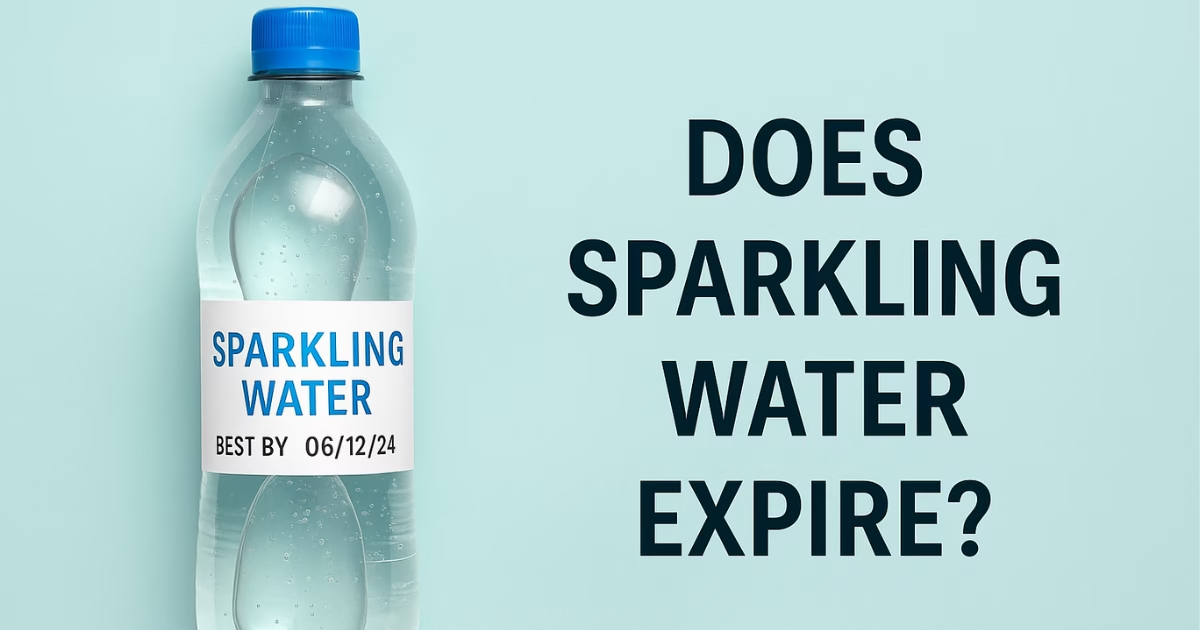Sparkling water has become a favorite drink for many people who enjoy its fizzy, refreshing taste. But as with any packaged product, a common question pops up — does sparkling water expire? Some people assume it lasts forever because it’s just water, while others worry about the “best by” date on the bottle. The truth lies somewhere in between. Although sparkling water doesn’t spoil like milk or juice, it can lose its fizz and freshness over time. If you’ve ever found an old bottle in the back of your fridge, you might have wondered if it’s still safe to drink. In this post, we’ll explore everything you need to know about the shelf life of sparkling water, how to store it, and how to tell when it’s time to toss it.
Does Sparkling Water Expire?
Yes, sparkling water can expire, but not in the way you might think. It doesn’t grow harmful bacteria or become toxic, especially if it’s unflavored and unopened. However, over time, it will lose carbonation, making it taste flat or dull. That’s why bottles and cans come with a “best by” or “expiration” date. These dates help ensure you enjoy the drink at its peak quality.
Once the carbonation fades, the drink won’t be as refreshing, and the flavor — if flavored — might start to taste off. In some cases, the container can even affect the taste. For example, plastic bottles may leach a slight chemical flavor after long storage. So while sparkling water doesn’t expire in a dangerous way, it can definitely decline in quality.
How Long Does Sparkling Water Last?
The shelf life of sparkling water depends on how it’s stored and the type of packaging. In general, unopened sparkling water lasts about 12 to 18 months from the production date. That’s why you’ll see a “best by” date printed on the bottle or can.
If the container is sealed and stored in a cool, dry place, the water usually stays safe to drink even months after the expiration date. But the fizz may start to fade, and the taste might not be as crisp.
Once opened, you should drink it within 1 to 2 days. After that, most of the carbonation escapes, leaving you with flat water.
The packaging matters too:
- Glass bottles hold carbonation better than plastic.
- Cans can last long, but once opened, they go flat quickly.
- Plastic bottles lose fizz faster due to their flexible material.
Signs Sparkling Water Has Gone Bad
Sparkling water doesn’t spoil like milk or soda, but it can go bad in its own way. Here are the most common signs:
- Flat or no bubbles: This is the most obvious clue. If there’s no hiss when you open the bottle, it’s gone flat.
- Strange smell: A chemical or sour odor could mean the container is compromised, especially with flavored varieties.
- Odd taste: Stale, metallic, or bitter flavor? Time to toss it.
- Visible changes: Discoloration or particles floating in flavored water are red flags.
- Damaged packaging: Bulging cans, broken seals, or rust spots can indicate contamination.
If any of these signs show up, it’s safer not to drink it—even if it’s just water.
Is It Safe to Drink Expired Sparkling Water?
In most cases, yes. Drinking expired sparkling water is not harmful if the container is sealed and shows no signs of damage. The worst that could happen is you’ll be sipping something flat and flavorless.
For unflavored sparkling water, it’s usually safe even after the expiration date. But for flavored versions, it’s a bit riskier. Ingredients like fruit extracts or sweeteners may degrade over time, leading to unpleasant taste or even mild stomach issues.
So, if you’re not sure, do a quick sniff and taste test. If it seems fine, it probably is.
Flavored vs. Unflavored Sparkling Water
Here’s where things get interesting. Flavored sparkling waters—like lemon, berry, or mango—don’t last as long as plain ones. Why?
Because they often contain:
- Natural or artificial flavors
- Fruit extracts
- Preservatives or sweeteners
These ingredients can break down or change over time, especially past the expiration date. You may notice:
- A weird aftertaste
- Sediment at the bottom
- Cloudy water instead of clear
Unflavored sparkling water, on the other hand, is just carbonated water. With no additives, it holds up much better and has a longer safe window.
How to Store Sparkling Water Properly
Proper storage makes a huge difference in keeping sparkling water fresh and fizzy. Follow these simple tips:
- Keep it cool: Store it in a pantry or fridge, away from sunlight.
- Avoid heat: High temperatures speed up carbonation loss.
- Keep bottles upright: Especially for plastic bottles, this prevents leaks or pressure issues.
- Don’t shake: Rough handling releases CO₂.
- Seal tightly after opening: Air exposure kills the fizz quickly.
For best results, refrigerate opened bottles and finish them within a day or two.
What Happens If You Drink Expired Sparkling Water?
If the bottle is clean and sealed, not much happens. You may not even notice a difference if it’s only a bit past its date.
However, here’s what could happen:
- Flat taste: No bubbles or “bite.”
- Dull flavor: Especially in flavored types.
- Slight stomach upset: Rare, and mostly from degraded ingredients in flavored varieties.
It won’t make you seriously sick unless the bottle is damaged or the water smells or tastes bad.
Does Sparkling Water in Glass Last Longer?
Yes, glass bottles are the best option for long-term storage. Why?
- Glass is non-reactive and keeps the carbonation sealed in better.
- It doesn’t absorb or release chemicals like plastic might.
- Glass bottles are tightly capped, holding in CO₂ longer.
If you’re buying in bulk or planning to store for months, choose glass over plastic or cans.
Shelf Life of Popular Sparkling Water Brands
Let’s look at how long some popular brands last:
| Brand | Shelf Life (Unopened) | Notes |
|---|---|---|
| LaCroix | 12 months | Flavored, loses taste after expiry |
| Perrier | 18–24 months | Glass bottles last longer |
| San Pellegrino | 18 months | Keep away from sunlight |
| Bubly | 12 months | Store cool to keep fizz |
| Spindrift | 9–12 months | Real fruit = shorter shelf life |
Always check the printed date for the best experience.
Expert Tips to Keep Your Sparkling Water Fresh
Want to enjoy every last bubble? Use these pro tips:
- Buy smaller bottles to avoid waste after opening.
- Check expiration dates before buying.
- Keep them in a dark spot — heat and light are fizz-killers.
- Don’t open until ready to drink.
- Use bottle caps or carbonation savers for partially used bottles.
Small changes = better bubbles!
Common Myths About Sparkling Water Expiry
❌ “It’s just water, it lasts forever.”
Wrong. The carbonation and added flavors degrade with time.
❌ “If it still fizzes, it’s fine.”
Not always. A drink can fizz but still taste off if it’s expired.
❌ “Canned sparkling water never goes bad.”
Cans protect from light, but they can rust or leak over time.
Clearing up these myths helps you make safer, smarter choices.
Also Read” 25 Fun Facts About Socks That’ll Knock Your Socks Off!
Final Thoughts
So, does sparkling water expire? Yes—but mostly in terms of taste and fizz. While it won’t spoil in the traditional sense, over time it can lose its sparkle and develop an off flavor, especially if it’s flavored.
If you store it properly and pay attention to expiration dates, you’ll enjoy every sip at its best. When in doubt, trust your nose, your tongue, and the condition of the packaging. A little care goes a long way in keeping your sparkling water fresh and fizzy.
FAQs
Can sparkling water go bad?
Yes, but not dangerously. It can lose carbonation or develop off flavors, especially if flavored or stored poorly.
Is it safe to drink expired sparkling water?
Usually yes—if it’s sealed, has no odd smell or taste, and the bottle is in good condition.
How can I tell if my sparkling water is expired?
Look for flatness, strange smells, or unusual taste. Damaged packaging is also a bad sign.
Does unopened sparkling water expire?
It doesn’t spoil quickly but loses fizz over time. Check the “best by” date for best results.
Can I store sparkling water at room temperature?
Yes, but cooler temps are better. Avoid heat and sunlight to keep the fizz longer.

Hi, I’m Shafy Ali – a curious mind and passionate writer at Celiac Magazine. I cover a little bit of everything, from everyday tips and how-tos to deeper dives into topics that spark conversation. I enjoy turning research into readable, relatable content that informs and inspires. Whatever the subject, I aim to keep it clear, engaging, and genuinely useful.

